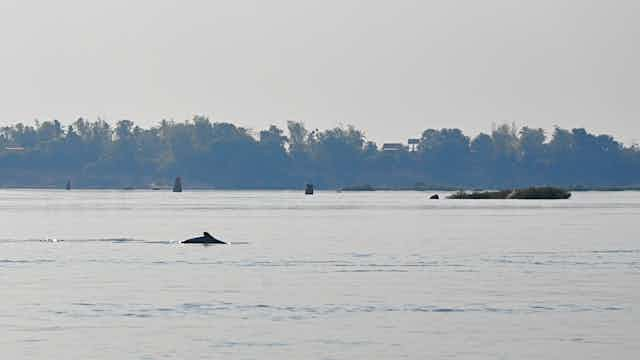It’s hot, and you’re sitting sweating in a small wooden boat. Your cold bottle of water is dripping, and the pink polyester roof does nothing to shade the glare of the setting sun. The young man at the back of the boat smiles and points at the water, and there you see it: one of Cambodia’s most magnificent spectacles.
Angkor Wat? No, it’s a critically endangered dolphin rising from the brown waters of the Mekong River, breathing, looking at you, and then disappearing below.
Our recent research suggests that while dolphin and whale tourism in Southeast Asia can be great for communities, it can also come at a cost to the environment.
So what should you look for if you’re going on tour?
Tourism boom
Dolphin- and whale-watching tourism is a booming industry worldwide, and it’s growing apace in developing parts of Asia. Many tourists flock to see spinner dolphins in Bali or Bohol; blue whales off Sri Lanka; Chinese white dolphins in Hong Kong; or Irrawaddy dolphins in great rivers like the Mekong and Ayeyarwaddy (as the Irrawaddy is now known).

This interest in seeing wildlife is a boon: it provides jobs for local people driving boats, selling souvenirs, or staffing restaurants and hotels. It also gives a growing Asian middle class the chance to get close to wildlife that many people are increasingly separated from in day-to-day life.
By providing jobs and building compassion for the species it targets, dolphin-watching tourism can thus provide an incentive to protect threatened species such as critically endangered river dolphins. But it has a cost.
Boat traffic can stress dolphins. What can seem like insignificant short-term stresses are known to have long-term costs on whole populations if they are repeated over a long time.
Tourist boats visiting dolphins several times a day can cause exactly this sort of problem, especially if they harass and chase animals. This happens in many places where regulation is absent or poorly enforced. We have seen large numbers of boats swarming groups of dolphins in many places.
Often such tourism is limited only by the numbers of boats and crews willing to conduct it. Understanding the long-term ecological effects of tourism activities on dolphin populations is difficult; it needs long-term data, which can be expensive and slow to collect.
This kind of work is rarely done, especially in developing Asia. So we don’t really know how tourism affects dolphins and whales in this area.
With colleagues, we recently developed a rapid risk-assessment method to understand the risk tourism poses to wildlife. We applied it to seven sites in six countries in developing Asia, including sites on the Mekong River in Cambodia, on the coasts of Bohol in the Philippines, Bali, Malaysian Borneo and Thailand, and in India’s Chilika Lagoon.
We found the highest risk from tourism was to Irrawaddy dolphins at Chilika Lagoon, and to spinner and other dolphins at Lovina Beach in Bali. Both of these sites have no regulation of the number of boats visiting dolphins, or how boats are operated around the animals. This leaves large numbers of boats free to chase dolphins around – hardly ideal.

How to travel lightly
The sites we assessed are just a drop in a sea full of opportunities to view wild whales and dolphins. So next time you’re heading out on holiday and considering going to see some of the water’s most charismatic inhabitants, how do you know if you should go?
Here’s a few things to consider:
Is there a land-based alternative to see the animals without disturbing them?
Is there a code of practice for boat operators to prevent stressing animals? This may not be obvious. Talk to other tourists about how boat drivers operate around animals. Avoid operators who chase, cut off, or otherwise harass animals.
Ask your driver not to chase animals, and reward them with thanks or tips for driving carefully around the animals.
Ask yourself how you can meaningfully contribute to the protection of these species in other ways.
Watching wild animals in their natural environment is one of life’s great experiences. Few things in this world are as uplifting as the sight of a dolphin breaking the water’s surface, and it’s a sight we hope everyone can enjoy for countless generations.
We’re sure we will be able to if we encourage responsible dolphin-watching tourism. And that can start with you on your next getaway into the wild!

